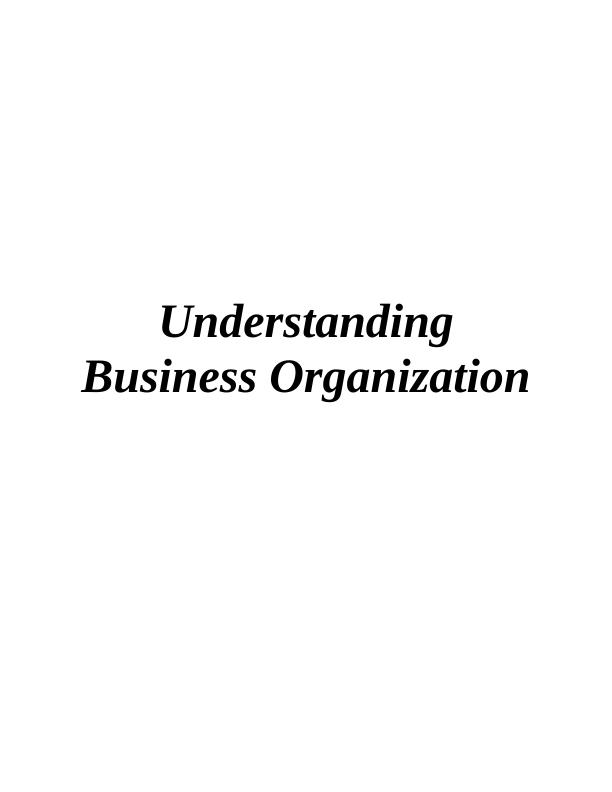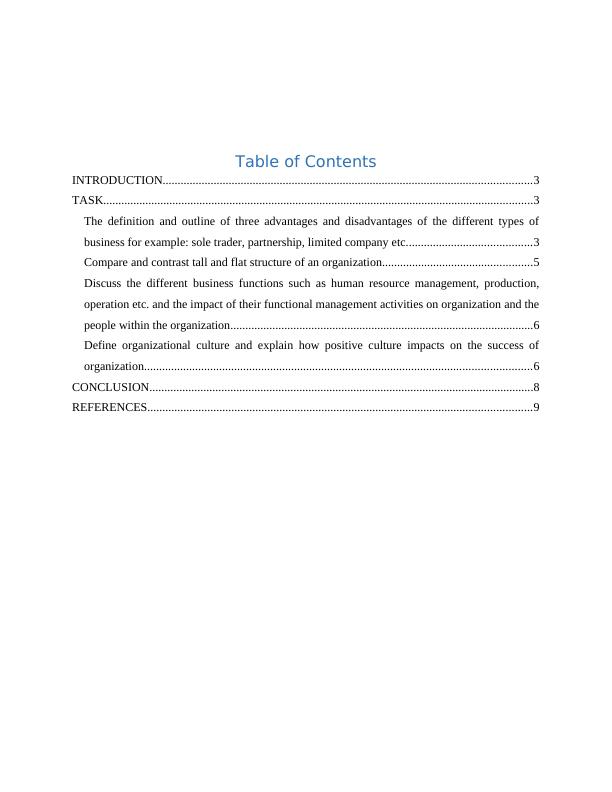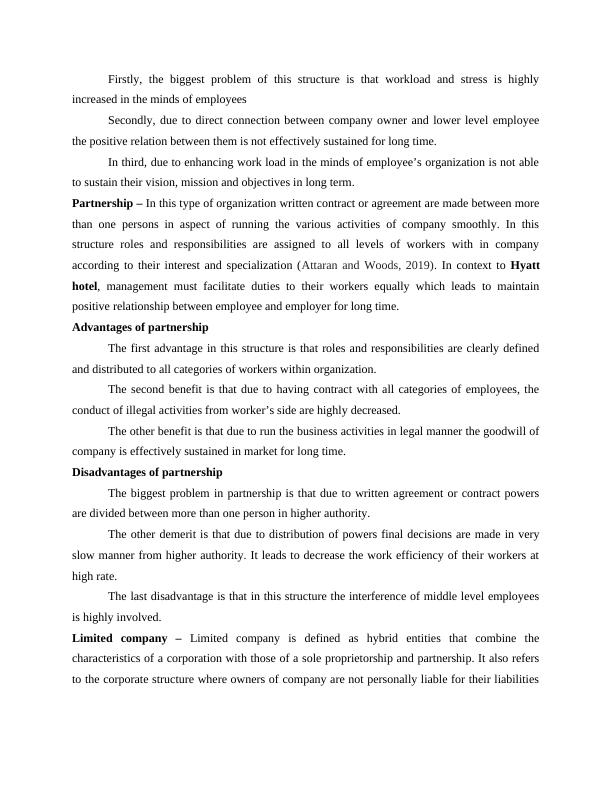Understanding business organisations and their environments
Added on 2023-06-10
11 Pages2197 Words323 Views
Understanding
Business Organization
Business Organization

Table of Contents
INTRODUCTION...........................................................................................................................3
TASK...............................................................................................................................................3
The definition and outline of three advantages and disadvantages of the different types of
business for example: sole trader, partnership, limited company etc..........................................3
Compare and contrast tall and flat structure of an organization..................................................5
Discuss the different business functions such as human resource management, production,
operation etc. and the impact of their functional management activities on organization and the
people within the organization.....................................................................................................6
Define organizational culture and explain how positive culture impacts on the success of
organization.................................................................................................................................6
CONCLUSION................................................................................................................................8
REFERENCES................................................................................................................................9
INTRODUCTION...........................................................................................................................3
TASK...............................................................................................................................................3
The definition and outline of three advantages and disadvantages of the different types of
business for example: sole trader, partnership, limited company etc..........................................3
Compare and contrast tall and flat structure of an organization..................................................5
Discuss the different business functions such as human resource management, production,
operation etc. and the impact of their functional management activities on organization and the
people within the organization.....................................................................................................6
Define organizational culture and explain how positive culture impacts on the success of
organization.................................................................................................................................6
CONCLUSION................................................................................................................................8
REFERENCES................................................................................................................................9

INTRODUCTION
Business organization is basically defined as an entity or the group which is developed for
the purpose of handling different types commercial activities within enterprise. This type of
organization is predicted on systems of law governing contract and exchange, incorporation and
property rights (Appio, Lima and Paroutis, 2019). Here various types of companies are selected
which comes in the category of hospitality and tourist industry which includes such as
intercontinental hotel, Hyatt hotel etc. The report will be covered definition and outline of three
advantages and disadvantages of the different types of business for example sole trader,
partnership and limited company. It also covers compare and contrast tall and flat structure of an
organization, discuss the different business functions such as human resource management,
production and operation and also explain the impact of their functional management activities
on organization and the people within the company. It further covers explanation of
organizational structure and discuss how positive culture impacts on the success of company.
TASK
The definition and outline of three advantages and disadvantages of the different types of
business for example: sole trader, partnership, limited company etc.
Sole trader – It is defined as that type of organization where whole powers are coming in the
hands of single person and that person is the owner of company. In this type of organization
whole operational and departmental functions is managed by individual person. Due to this it is a
highly simple and effective structure for intercontinental hotel in aspect of increasing their
performance and productivity at maximum level.
Advantages of sole trader -
Firstly, in this structure intermediaries are very low and due to this the performance of the
employees are strictly monitored on regular basis.
Secondly, in this structure decisions are made quickly from top level management which
leads to increase the work efficiency of company at maximum level.
In third, according to this structure lower level employees are able to share their problems
to higher authorities directly and freely.
Disadvantages of sole trader -
Business organization is basically defined as an entity or the group which is developed for
the purpose of handling different types commercial activities within enterprise. This type of
organization is predicted on systems of law governing contract and exchange, incorporation and
property rights (Appio, Lima and Paroutis, 2019). Here various types of companies are selected
which comes in the category of hospitality and tourist industry which includes such as
intercontinental hotel, Hyatt hotel etc. The report will be covered definition and outline of three
advantages and disadvantages of the different types of business for example sole trader,
partnership and limited company. It also covers compare and contrast tall and flat structure of an
organization, discuss the different business functions such as human resource management,
production and operation and also explain the impact of their functional management activities
on organization and the people within the company. It further covers explanation of
organizational structure and discuss how positive culture impacts on the success of company.
TASK
The definition and outline of three advantages and disadvantages of the different types of
business for example: sole trader, partnership, limited company etc.
Sole trader – It is defined as that type of organization where whole powers are coming in the
hands of single person and that person is the owner of company. In this type of organization
whole operational and departmental functions is managed by individual person. Due to this it is a
highly simple and effective structure for intercontinental hotel in aspect of increasing their
performance and productivity at maximum level.
Advantages of sole trader -
Firstly, in this structure intermediaries are very low and due to this the performance of the
employees are strictly monitored on regular basis.
Secondly, in this structure decisions are made quickly from top level management which
leads to increase the work efficiency of company at maximum level.
In third, according to this structure lower level employees are able to share their problems
to higher authorities directly and freely.
Disadvantages of sole trader -

Firstly, the biggest problem of this structure is that workload and stress is highly
increased in the minds of employees
Secondly, due to direct connection between company owner and lower level employee
the positive relation between them is not effectively sustained for long time.
In third, due to enhancing work load in the minds of employee’s organization is not able
to sustain their vision, mission and objectives in long term.
Partnership – In this type of organization written contract or agreement are made between more
than one persons in aspect of running the various activities of company smoothly. In this
structure roles and responsibilities are assigned to all levels of workers with in company
according to their interest and specialization (Attaran and Woods, 2019). In context to Hyatt
hotel, management must facilitate duties to their workers equally which leads to maintain
positive relationship between employee and employer for long time.
Advantages of partnership
The first advantage in this structure is that roles and responsibilities are clearly defined
and distributed to all categories of workers within organization.
The second benefit is that due to having contract with all categories of employees, the
conduct of illegal activities from worker’s side are highly decreased.
The other benefit is that due to run the business activities in legal manner the goodwill of
company is effectively sustained in market for long time.
Disadvantages of partnership
The biggest problem in partnership is that due to written agreement or contract powers
are divided between more than one person in higher authority.
The other demerit is that due to distribution of powers final decisions are made in very
slow manner from higher authority. It leads to decrease the work efficiency of their workers at
high rate.
The last disadvantage is that in this structure the interference of middle level employees
is highly involved.
Limited company – Limited company is defined as hybrid entities that combine the
characteristics of a corporation with those of a sole proprietorship and partnership. It also refers
to the corporate structure where owners of company are not personally liable for their liabilities
increased in the minds of employees
Secondly, due to direct connection between company owner and lower level employee
the positive relation between them is not effectively sustained for long time.
In third, due to enhancing work load in the minds of employee’s organization is not able
to sustain their vision, mission and objectives in long term.
Partnership – In this type of organization written contract or agreement are made between more
than one persons in aspect of running the various activities of company smoothly. In this
structure roles and responsibilities are assigned to all levels of workers with in company
according to their interest and specialization (Attaran and Woods, 2019). In context to Hyatt
hotel, management must facilitate duties to their workers equally which leads to maintain
positive relationship between employee and employer for long time.
Advantages of partnership
The first advantage in this structure is that roles and responsibilities are clearly defined
and distributed to all categories of workers within organization.
The second benefit is that due to having contract with all categories of employees, the
conduct of illegal activities from worker’s side are highly decreased.
The other benefit is that due to run the business activities in legal manner the goodwill of
company is effectively sustained in market for long time.
Disadvantages of partnership
The biggest problem in partnership is that due to written agreement or contract powers
are divided between more than one person in higher authority.
The other demerit is that due to distribution of powers final decisions are made in very
slow manner from higher authority. It leads to decrease the work efficiency of their workers at
high rate.
The last disadvantage is that in this structure the interference of middle level employees
is highly involved.
Limited company – Limited company is defined as hybrid entities that combine the
characteristics of a corporation with those of a sole proprietorship and partnership. It also refers
to the corporate structure where owners of company are not personally liable for their liabilities

End of preview
Want to access all the pages? Upload your documents or become a member.
Related Documents
Understanding Business Organizations: Types, Structures, Functions, and Culturelg...
|8
|2178
|178
Understanding Business Organisations - Essaylg...
|8
|2131
|430
Understanding Business Organizations: Types, Structures, Functions, and Culturelg...
|8
|2225
|212
Types of Business, Organizational Structure, Business Functions and Organizational Culturelg...
|9
|2329
|89
Understanding Business Organizations: Types, Functions, and Organizational Culturelg...
|8
|1994
|350
Understanding Business Organization and Organizational Culturelg...
|8
|2059
|403